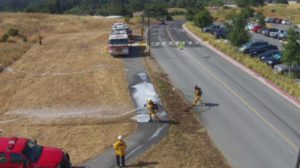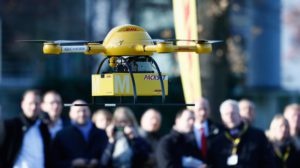How Are Drones Being Used by Utility Companies for Inspections
In the rapidly evolving utility sector, companies are continually seeking methods to enhance efficiency, improve safety, and reduce operational costs. A significant innovation that has emerged as a game-changer is the use of drones for inspections. This technology is not just a futuristic concept but a practical tool that is being actively integrated into the routine operations of utility companies. Drones, or commercial Unmanned Aerial Vehicles (UAVs), are now at the forefront of conducting visual inspections across various types of infrastructure, from electrical lines to wind turbines, revolutionizing the way inspections are carried out.
The Transformation Brought by Drones
Drones offer a multitude of advantages over traditional inspection methods, which were not only time-consuming but also posed significant risks to personnel required to manually inspect high-risk areas. The integration of drone technology into utility inspections has marked a significant shift towards increased efficiency, cost effectiveness, and safety.
Reduced Cost and Increased Efficiency
One of the most compelling advantages of using drones for utility inspections is the substantial cost savings and increased efficiency they offer. Drones can cover vast areas in a fraction of the time it would take ground crews to perform the same task, providing real-time, high-resolution data that can be analyzed promptly . This means that utility companies can conduct inspections more frequently and thoroughly, without the need to deploy extensive human resources, thereby reducing operational costs significantly.
Improving Safety and Data Collection
The safety benefits of utilizing drones for inspections cannot be overstated. By employing drones to inspect dangerous or hard-to-reach areas, utility companies significantly increase safety by reducing the need for workers to physically access these locations . Furthermore, drones equipped with advanced sensors and cameras can collect a variety of data types, from visual to thermal, offering a comprehensive view of the infrastructure’s condition that was previously unattainable without considerable effort and risk.
Application Across Utility Sectors
Utility companies across different sectors are finding drones to be invaluable for a wide range of applications. For electrical utilities, drones are used to inspect overhead lines and substations, identifying issues that could lead to outages before they happen. In the renewable energy sector, particularly with wind turbines, drones inspect blades and towers for damage, allowing for timely maintenance and repairs . The water sector also benefits from drone technology for monitoring water levels, inspecting dams, and other critical infrastructure components, ensuring the integrity and safety of water supply systems.
Real-world Examples and Success Stories
Several utility companies have already documented significant successes with drone inspections. These real-world applications highlight not just the potential, but the proven benefits of drone technology in the utility industry. From identifying potential issues before they lead to system failures, to documenting infrastructure conditions post-natural disasters, drones are proving to be an indispensable tool in the utility toolkit.
What are the best drones for utility inspections?
For utility line inspections, you’ll want drones that offer stability, endurance, high-resolution cameras, and possibly thermal imaging capabilities. Below is a short list of drones commonly used for utility line inspections:
- DJI Matrice 300 RTK: This is a powerful commercial-grade drone known for its stability and endurance. It supports multiple payloads, including high-resolution cameras and thermal imaging cameras. It also has advanced features like AI capabilities for automated inspections and mission planning.
- DJI Mavic 2 Enterprise or Thermal: This compact and foldable drone features a thermal camera alongside a standard camera, making it suitable for both visual and thermal inspections of utility lines. Its portability and ease of use are advantageous for field operations.
- Wingtra One Gen II: This fixed-wing drone offers long flight times and large coverage areas, making it ideal for inspecting extensive utility line networks. It can carry various payloads, including high-resolution RGB cameras and LiDAR sensors for detailed inspections.
- Parrot Anafi Thermal: This lightweight and portable drone is equipped with a thermal camera, making it suitable for identifying hotspots along utility lines. It’s a cost-effective option for smaller-scale inspections.
- FLIR SkyRanger R70: Developed specifically for industrial inspections, this drone comes equipped with FLIR thermal imaging technology for identifying anomalies along utility lines, even in challenging environmental conditions.
When choosing a drone for utility line inspections, consider factors such as flight time, payload capacity, camera quality, data transmission range, and compatibility with inspection software. Additionally, ensure that the drone and its pilot meets regulatory requirements for commercial operations in your region. I.e. Many utility companies are looking for ASDA, NDAA compliant drones due to the critical infrastructure that transmission and distribution lines represent to the USA. For these considerations one might explore the Inspired Flight lineup of drones.
Conclusion
The use of drones for inspections by utility companies is a testament to the industry’s innovation and adaptability. As drone technology continues to evolve, offering ever more sophisticated data collection and analysis capabilities, its role in utility inspections is set to become even more integral. With benefits ranging from reduced cost to improved safety and increased efficiency, drones are not just reshaping how utility inspections are conducted—they are setting a new standard for operational excellence in the utility sector.
For more detailed insights and examples of how utility companies are leveraging drones for inspections, explore these comprehensive resources:
- GovTech’s insights on drones in utility companies
- The Daily Record’s overview on area utility companies using drones
- The Utility Expo’s discussion on drones driving success in the utility industry
- AgileThought’s reasons why utilities are turning to drones
This exploration into the utility sector’s adoption of drones for inspections underscores a broader trend towards technological innovation and efficiency. As this trend continues, expect to see drones becoming an ever-more common sight above our critical infrastructure, silently ensuring its integrity, safety, and reliability.


